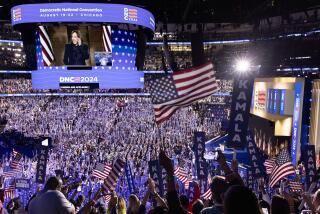Measure of Convention Success More Than ‘Bounce,’ Ratings
- Share via
BOSTON — How can you tell whether this week’s Democratic National Convention, opening today, is a success or a failure?
Easy -- just watch the numbers.
A good convention gives its candidate a measurable “bounce” in public opinion, like the eight percentage points Al Gore gained in Los Angeles in 2000, or the stunning 16 points Bill Clinton picked up at Madison Square Garden in 1992. A bad convention ends with no bounce at all.
A good convention, like a good infomercial, wins television viewers; a bad convention falls flat in the Nielsen ratings.
But Nielsen ratings and bounce -- the increase in the share of voters who say they plan to vote for the featured candidate -- aren’t the only measures of a convention’s success. This year, with less network television coverage than before and fewer undecided voters to persuade, they may not be the best ones, either.
The more important measures this year, Democratic strategists and some Republicans say, is a more subjective question: Can Sen. John F. Kerry use his time in the spotlight to persuade swing voters that he is strong enough, in personality and convictions, to be president?
“Kerry’s got to turn a corner at this convention,” said Leon E. Panetta, White House chief of staff under President Clinton. “The question is whether or not he’s established a comfort level with the American people that he represents a legitimate alternative to George W. Bush.”
James Carville, Clinton’s top strategist in the 1992 campaign, said: “My definition of success is ... can they use the convention to convey a sense of who the candidate is, and will they have the discipline to stick to it and drive it home?”
Republican pollster Frank Luntz was blunter. “The key for Kerry is [persuading voters of] a single attribute: that he says what he means and means what he says,” he said.
If Kerry and his aides can shape the convention to serve those goals, the strategists said, then the event will be a success -- and the bounce will follow.
But how big a bounce? That’s one of the most hotly debated political issues of the week, with both campaigns trying madly to set public expectations.
Matthew Dowd, President Bush’s chief campaign strategist, claims the convention can not be considered a success if Kerry’s bounce in the polls falls short of an ambitious 15 percentage points. Democrats accuse Dowd of setting a deliberately unfair benchmark.
“You’ve only got about 4% undecided in this race,” said Carville. “So it’s absurd to think you could see a bounce of 12% or more.” (The Times Poll found 7% of voters undecided, but Carville, joining in the battle of numbers, said he thinks 4% is closer.)
In Gallup polls since 1964, the average bounce for a candidate challenging an incumbent president has been about seven percentage points.
The most recent CNN/USA Today/Gallup Poll put Kerry at 47%, with Bush at 46% and independent Ralph Nader at 4%. Other recent national surveys, including last week’s Times Poll, got similar results. That means if Kerry matches the average bounce for his situation, his share of the vote should rise to about 54% after the convention.
Dowd calculated the bounce phenomenon differently, which resulted in his higher bar for Kerry. Dowd said that in Gallup polls since 1976, the average challenger has gained about 15 percentage points -- post-convention -- in his margin of advantage over the incumbent.
Since Kerry and Bush head into the Democratic convention locked in a virtual dead heat, “historical analysis suggests John Kerry should have a lead of more than 15 points coming out of his convention,” Dowd wrote in a much-discussed memo earlier this month.
To which the Kerry campaign responds: nonsense. With the electorate so polarized between the parties -- and Bush and Kerry already engaged for more than four months in a general election campaign -- Democrats argue that the number of persuadable voters is much smaller than in previous years.
As a result, Kerry aides insist, it is unrealistic to expect Kerry to receive a bounce as large as previous challengers. Instead, senior advisors such as Tad Devine insist their goal is not so much to move the head-to-head race but to deepen voters’ personal impressions of Kerry. Polls consistently show that many Americans now hold only shallow or fragmentary impressions of the Massachusetts senator.
In The Times Poll last week, one-third of voters said they did not know enough about Kerry to determine whether he would be a better president than Bush.
And when voters do know something about Kerry, it isn’t always positive. The Times Poll found that 43% of voters said Kerry flip-flops, compared with only 31% for Bush.
“The goal is to take people who are now for Kerry because they dislike Bush, and move them to a place where they are for Kerry because they like Kerry,” said Devine.
Devine and other Kerry aides said they view it as urgent to “lock in” voters this week because they expect the Bush campaign to launch a massive advertising campaign against the Democrat next month. Bush had more than $60 million in the bank in his latest campaign finance report, and cannot legally spend any of that money after accepting the GOP nomination in early September.
“I believe they will have a media buy in August the likes of which we have never seen before,” said Devine. “If we can do a lot of this work at the convention, it is going to help us withstand those attacks.”
The focus on improving assessments of Kerry’s personal attributes follows the main trend in convention strategy in the past quarter of a century: a shift in emphasis from a candidate’s agenda to his biography.
For campaign planners, the gold standard has become a convention that fuses biography and agenda by presenting a candidate’s platform as an organic outgrowth of his life and experiences. Perhaps the most successful example in recent times was provided by Clinton in 1992.
In his acceptance speech, Clinton effectively presented himself as both a product and defender of the middle-class, committed to providing others with the same opportunity he enjoyed as the product of “a place called Hope,” the small Arkansas town where he was born.
“That was the model of how to do it,” Panetta said.
Times staff writer Nick Anderson contributed to this report.
More to Read
Get the L.A. Times Politics newsletter
Deeply reported insights into legislation, politics and policy from Sacramento, Washington and beyond. In your inbox three times per week.
You may occasionally receive promotional content from the Los Angeles Times.











